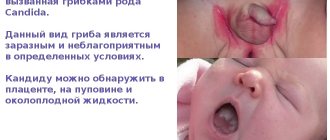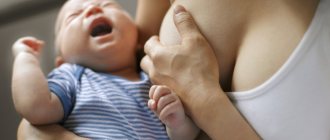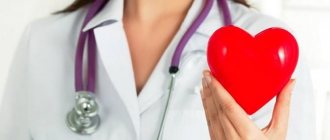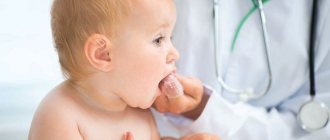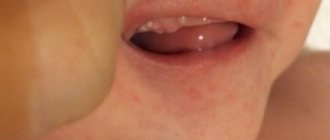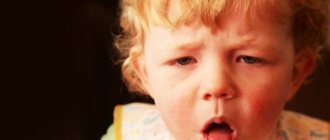Last updated: July 24, 2020
Allergic rashes in children are a very common and common occurrence. Most often, this disease manifests itself in the form of a rash, but the causes can be different. You will learn in this article how allergic rashes in children are treated and what they are like.
- For what reason does an allergic rash appear on a child's skin?
- What does a child's skin allergy look like?
- How to diagnose allergies?
- First aid and treatment
- What is done to prevent allergic rashes in children?
- Types of allergic reactions with photos
- Conclusion
Causes
Allergic rashes can occur in children from birth until the age of 7 years. This is explained by the fact that the immune system has not yet been formed. Below are the main causes of allergic reactions in children:
- Medicines, the body may react negatively to some components of medicines;
- Breast milk if the diet is not followed;
- Hygiene products and household chemicals;
- Plants and animals can also cause rashes;
- Ultra-violet rays;
- Various infections and diseases.
Treatment of rash on the labia
A rash is a symptom, so the main therapy is prescribed taking into account the cause that led to the appearance of a rash in the intimate area. For allergies, antihistamines are prescribed, for fungal infections - antifungal drugs, hormonal disorders are eliminated with hormone therapy, genital herpes is treated with Acyclovir. If a streptococcal infection is detected, streptocide is prescribed; if there is an inflammatory process, the patient is recommended to undergo a course in a hospital.
The therapeutic regimen is selected taking into account test results, the course and complexity of the disease. Additionally, it is advisable to take a vitamin-mineral complex, immunomodulators, and sedatives of plant origin. In some cases, rehabilitation is necessary.
What do allergic rashes look like?
There are a large number of types of allergy rashes in children, it all depends on the irritant that caused it. In many cases, exanthemas appear on the child’s body (this is the name given to various manifestations of allergic rashes):
- pustules (filled with pus);
- plaques;
- spots;
- vesicles (filled with liquid);
- blisters (large vesicles larger than 0.5 cm).
With food allergies in children, the rash can be found primarily on the cheeks and near the mouth. With a contact allergy, a rash or irritation will appear in the area where the allergen touched. If the child’s body reacts negatively to medications, inflammation will appear in the area of the lymph nodes.
Why does it happen?
Many pediatric studies have proven that the skin and mucous membranes of newborns are thinner than those of adults, so babies often encounter rashes of different locations, including in the lower or upper lip. In a child, yellow or white small pimples may be the result of disorders of certain internal organs and systems. If acne appears inside the mouth or outside the lip, this may indicate the influence of such factors:
- dermatitis of various types and severity;
- use of low-quality or unsuitable epidermal care products;
- a constant urge to put fingers or other dirty objects in your mouth;
- diseases of viral or bacterial origin;
- cold;
- hormonal changes;
- insufficient hygiene procedures or their absence;
- anatomical features of the body, as a result of which the sebaceous glands are displaced;
- narrowing of the ducts and blockage of the glandular channels;
- mechanical damage in the lip area.
How to diagnose allergies?
An allergic rash in children is often confused with an infectious one. If the treatment is incorrect, then the consequences of such a therapeutic course will not be the best. Before choosing an effective remedy, you need to learn to distinguish one disease from another. Only a doctor can make an accurate diagnosis, since a visual examination is not always enough to determine the cause of the disease; tests are required.
| Features | Allergic rash | Infection |
| General form | It can be in the form of both small dots and large blisters. In addition to them, there are often crusts, erosions and serous wells (ulcers from which fluid oozes). | The rashes are pinpoint and do not “merge” into a large spot. |
| Place of appearance | Face (forehead, cheeks, chin). Neck, arms, legs, buttocks. Rarely – stomach, back. | Belly, back. Rarely – arms, legs. Very rarely - forehead. |
| Heat | The temperature is rare, and if it rises, it is not higher than 37-38°C. | The disease is accompanied by fever, from 37°C to 41°C. |
| Itching | Happens. | Happens. |
| Swelling | Well visible. In some situations it is life-threatening. | They happen very rarely. |
| Associated symptoms | Lacrimation, conjunctivitis, hyperemia of the mucous membrane of the eye, decreased blood pressure, cough, upset stomach. | Running nose, general loss of strength, body aches. |
| How quickly it goes | Often the rash goes away immediately after taking the medicine. | Remains until the course of treatment is completed. |
Varieties
White pimples
Numerous painless white pimples on the lips indicate blockage of the sebaceous glands.
Such a pimple on the lip or in the corners of the baby’s mouth most often indicates a blockage of the sebaceous gland, as a result of which a subcutaneous vesicle filled with fat is formed. The rash can be multiple or one large pimple forms in the corner of the mouth, which takes a long time to go away. These tumors rarely cause pain or other unpleasant symptoms.
Transparent rashes
If a child develops a rash of this type in the lip area, this most likely indicates a mechanical lesion of the mucous membrane. A bubble is often fixed on the damaged area, which occurs as a result of regular exposure of the surface of the wound to the external environment. Water pimple in a child may also indicate a thermal burn that occurs when eating hot food or high-temperature drinks. These rashes are usually painful, especially if exposed to them frequently.
Features of ulcers
This type of acne is less dangerous and is associated with the penetration of bacteria and other pathogenic microorganisms into the pores and sebaceous glands. The pimple is small in size and is accompanied by an inflammatory reaction, and it becomes obvious when it matures and grows to a large size. In a child, a similar problem is associated with insufficient hygiene or keeping foreign objects in the mouth.
First aid and treatment
If children develop an allergic rash on their skin, it is strictly forbidden to squeeze pimples or open blisters. It is necessary to explain to the child that it is also forbidden to scratch the sores.
If he is still too small, make sure that he does not touch the wounds with dirty hands. He can get an infection, and this will only worsen his condition.
Treatment of rashes in children is selected depending on the type of disease. Parents who do not know how to treat allergic rashes in children should not select medications on their own.
Which doctor should I contact for a rash on the labia?
If a rash appears in the labia area, it is initially recommended to consult a therapist who will differentiate and make a primary diagnosis. Based on these results, the specialist will select a specialist doctor.
The list of such doctors includes:
- gynecologist;
- dermatologist;
- venereologist;
- endocrinologist;
- allergist.
Each of these specialists will be able to make a final diagnosis, prescribe a series of examinations and select effective, safe treatment. If the cause is external irritants, incorrect attitude to hygiene, incorrectly chosen cosmetics or pads, then the appointment ends with a therapist, who recommends eliminating all negative factors.
How to avoid allergies in children?
Preventive measures will prevent the child from developing an allergic rash. Doctors give the following recommendations:
- Make sure that the baby does not come into contact with the allergen (remove allergenic foods from his diet; if necessary, change baby powder, soap or dishwashing liquid.
- Maintain order in his room, regularly do wet cleaning.
- If there are pets in the house, keep them clean.
- Strengthen the baby’s immunity (walk more often, play sports).
- Do not violate your doctor’s recommendations for taking medications.
Molluscum contagiosum in a child
Conservative therapy
Despite the possible independent resolution, patients with molluscum contagiosum are subject to treatment in order to prevent autoinfection and infection of other children. Any uncomplicated forms of the disease in a child are treated on an outpatient basis. The doctor selects the method of therapy individually, based on the patient’s age, the prevalence of the process, and the presence of concomitant pathology. Disseminated forms require systemic administration of interferon-based antiviral drugs. The main direction in therapy is destruction of rashes with elimination of the pathogen.
Chemical destruction
The use of ointments and creams is advisable for single elements. Local conservative techniques include applications of trichloroacetic acid, silver nitrate, and iodine. The essence of the method is to activate local immunity in response to damage to the epidermis by drugs. Patches with salicylic or retinoic acid are also used. This technique is not recommended for children with concomitant dermatitis, as it may cause additional skin irritation.
Cryodestruction
The technique involves freezing the rashes with liquid nitrogen. Suitable for removing small, few lesions of molluscum contagiosum. Cryodestruction is carried out by applying low-temperature nitrogen to the damaged skin with a swab or an aerosol cryodestructor. The method is almost painless and requires several sessions for recovery.
Radio wave destruction
The essence of the method is the irradiation of elements with radio frequency waves (“radio knife”). After local anesthesia, the nodule is targeted with a beam from a special device. The procedure is non-invasive, bloodless, and does not leave scars.
Electrocoagulation
It is performed using local anesthesia. The principle of the technique is to influence the formation of high-frequency currents with the destruction of pathogen bodies. Electrocoagulation makes it possible to effectively destroy the elements of molluscum contagiosum over a large affected area, guaranteed to prevent the spread of infection. After the procedure, dry crusts remain, which peel off without forming a scar.
Laser destruction
Non-contact, painless method of removing nodular rash using a laser beam. The beam of light destroys the papule with the virus contained inside, coagulates the blood vessels, minimizing the risk of relapse. After the procedure, traces of hyperemia are possible, which disappear after a few days without consequences. Laser therapy allows you to treat lesions of any size in one session.
Surgery
Surgical removal of molluscum contagiosum is performed by a pediatric surgeon under local or general anesthesia. To remove rashes, use tweezers, a curette or a Volkmann spoon. After desquamation, the surgical field is treated with antiseptic solutions. The method is acceptable for fresh rashes, if pathohistological examination of the material is necessary. Surgical intervention is undesirable in children with atopic dermatitis.
Examples of rashes with photos
Colorless rash "goosebumps"
Exudative diathesis
Hives
Food allergies

